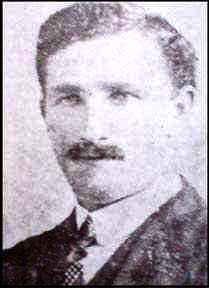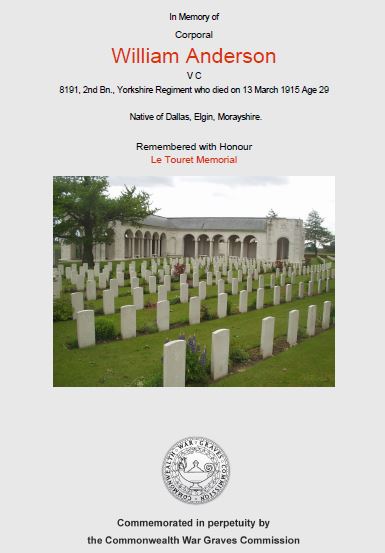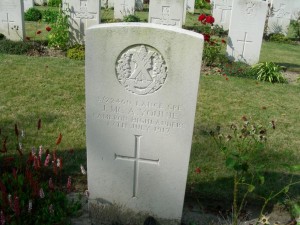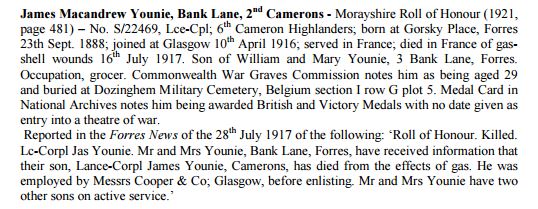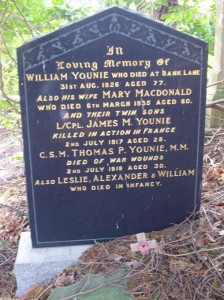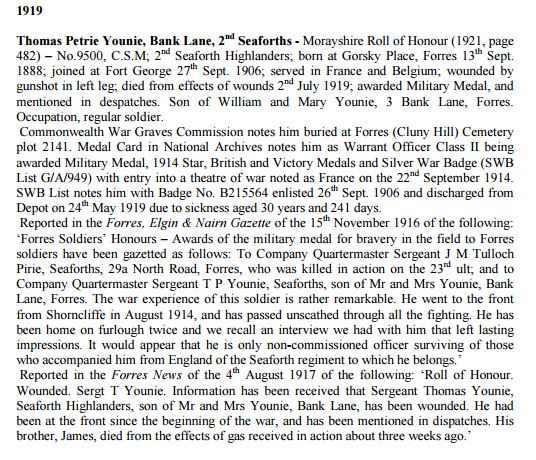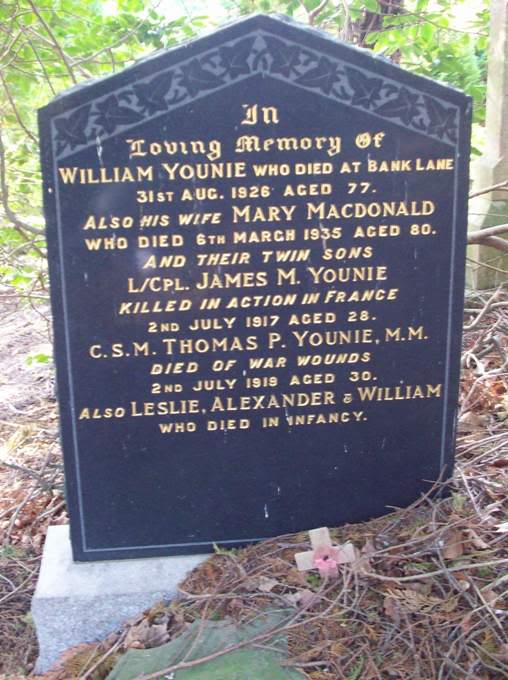After seeing a link to an online version of the Press and Journal, a Scottish newspaper, I was very interested, as the young man concerned was from the same village as my grandad – Dallas, Morayshire.
William Anderson was born in 1885 in Dallas, but by 1891, the family consisting of Alexander and Bella, the parents, plus children, James, Maggie, William and Alexander, living at 79 North Road. Alexander snr., worked as a labourer to keep a roof over his family’s head.
He went to Glasgow and was employed as a car conductor with the Corporation Tramways for several years before moving to Newcastle upon Tyne where an elder brother of the family was serving with the Yorkshire Regiment (Alexandra, Princess of Wales’s Own) and enlisted in the same battalion in 1905, serving in it for a period of seven years in Egypt and India. After his service expired William returned to Glasgow and was employed in the Elder Hospital in Govan. He had been there only for a year before deciding to emigrate to South Africa. However, before he could leave war broke out and he was called up as a reservist and went to the front in France with the British Expeditionary Force.
Our soldier, William Anderson, served in the 2nd Battalion, Yorkshire Regiment. He served as Corporal, 8191.
An extract from “The London Gazette”, dated 21st May, 1915, records the following: “For most conspicuous bravery at Neuve-Chapelle on 12th March, 1915, when he led three men with bombs against a large party of the enemy who had entered our trenches, and by his prompt and determined action saved, what might otherwise have become, a serious situation. Cpl. Anderson first threw his own bombs, then those in possession of his three men (who had been wounded) amongst the Germans, after which he opened rapid rifle fire upon them with great effect, notwithstanding that he was at the time quite alone”.
William’s commanding officer wrote him up for his Victoria Cross – he had died within less than 24 hours, his Soldier’s Effects record states ‘on or since 13.3.15’. The document also mentions his sister, Mrs Margaret Ingram and his brother Alexander, who would receive monies owed to William. Various payments had been made to his siblings covering the period 10 May 1916 to 2 December 1919.
Anderson, William V.C., Corporal 8191, has no known grave and is therefore, remembered on the Le Touret Memorial, along with over 13400 other men whose final resting place is known only unto their God.
The Memorial commemorates, as I have said, over 13,400 British soldiers who were killed in this sector of the Western Front from the beginning of October 1914 to the eve of the Battle of Loos in late September the following year – 1915.
Extracted from the Commonwealth War Graves Commission “Almost all of the men commemorated on the Memorial served with regular or territorial regiments from across the United Kingdom and were killed in actions that took place along a section of the front line that stretched from Estaires in the north to Grenay in the south. This part of the Western Front was the scene of some of the heaviest fighting of the first year of the war, including the battles of La Bassée (10 October – 2 November 1914), Neuve Chapelle (10 – 12 March 1915), Aubers Ridge (9 – 10 May 1915), and Festubert (15 – 25 May 1915). Soldiers serving with Indian and Canadian units who were killed in this sector in 1914 and ’15 whose remains were never identified are commemorated on the Neuve Chapelle and Vimy memorials, while those who fell during the northern pincer attack at the Battle of Aubers Ridge are commemorated on the Ploegsteert Memorial”.
To read the continuing story of William and his V.C. visit the Press and Journal’s website
For information on other men from the Yorkshire Regiment you might find this of interest.
